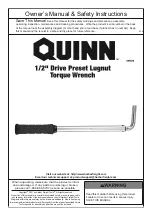
-3-
D4107 4-Ton Come-Along Instructions
Pulling Capacity
When all other conditions of the pulling operation remain
the same, pulling capacity reduces as the incline increas-
es. For example, when using the come-along in a single-
line configuration, the rated pulling capacity is 4000 lbs.
at a 0° incline. As illustrated in
Figure
4, this pulling
capacity reduces as the incline increases.
The conditions of your operation directly affect the pull-
ing capacity of your come-along. For instance, the initial
pulling capacity reduces if the load does not have wheels
and is at a "dead stop". Conversely, the pulling capacity
increases when pulling a floating object across water.
10°
0°
20°
30°
40°
45°
4000
3000
2000
1000
Weight (lbs.) Of Rolling Load
De
gree Of
In
cline
Pulling
Capacity
Figure
4
.
Example graph showing the
pulling capacity reduces as the incline
increases.
NOTICE
The pulling capacity of the come-along will vary with
the conditions of the operation. Always be aware
of these conditions when determining the pulling
weight of the load.
Single & Double-Line Setups
A single-line setup is when the hook at the end of the
pulling cable is connected to an attachment accessory
on the load, such as a sling or eyebolt (see
Figure
5 for
examples).
In a double-line setup, the pulling cable is doubled back
to the come-along body and forms a loop (see
Figure
6).
To configure the come-along for a double-line setup, con-
nect the hook at the end of the pulling cable (1
st
hook)
onto the hanger. The hook in the middle of the cable (2
nd
hook) becomes the end hook of the pulling cable, and will
attach to the load.
Chain
Sling
Eyebolt
Figure
5
.
Examples of hooking up to the
load.
Figure
6
.
Double-line setup.
Hanger
1
st
Hook
2
nd
Hook
Summary of Contents for D4107
Page 6: ......
























